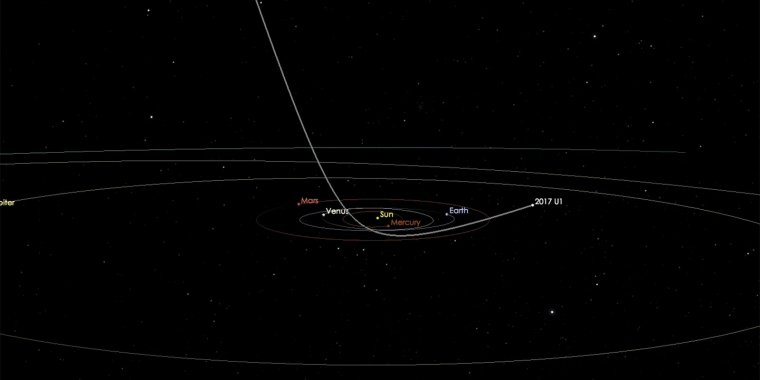| News / Science News |
Small Asteroid or Comet 'Visits' from Beyond the Solar System
A small, recently discovered asteroid -- or perhaps a comet -- appears to have originated from outside the solar system, coming from somewhere else in our galaxy. If so, it would be the first "interstellar object" to be observed and confirmed by astronomers.

The path of A/2017 U1 as it passed through our inner solar system in September and October 2017. ![]()
This unusual object - for now designated A/2017 U1 - is less than a quarter-mile (400 meters) in diameter and is moving remarkably fast.
Astronomers are urgently working to point telescopes around the world and in space at this notable object. Once these data are obtained and analyzed, astronomers may know more about the origin and possibly composition of the object.
A/2017 U1 was discovered Oct. 19 by the University of Hawaii's Pan-STARRS 1 telescope on Haleakala, Hawaii.
"This is the most extreme orbit I have ever seen," said Davide Farnocchia, a scientist at NASA's Center for Near-Earth Object Studies (CNEOS) at the agency's Jet Propulsion Laboratory in Pasadena, California. "It is going extremely fast and on such a trajectory that we can say with confidence that this object is on its way out of the solar system and not coming back."
The CNEOS team plotted the object's current trajectory and even looked into its future. A/2017 U1 came from the direction of the constellation Lyra, cruising through interstellar space at a brisk clip of 15.8 miles (25.5 kilometers) per second.
The object approached our solar system from almost directly "above" the ecliptic, the approximate plane in space where the planets and most asteroids orbit the Sun, so it did not have any close encounters with the eight major planets during its plunge toward the Sun.
On Sept. 2, the small body crossed under the ecliptic plane just inside of Mercury's orbit and then made its closest approach to the Sun on Sept. 9.
Pulled by the Sun's gravity, the object made a hairpin turn under our solar system, passing under Earth's orbit on Oct. 14 at a distance of about 15 million miles (24 million kilometers). It has now shot back up above the plane of the planets and, travelling at 27 miles per second (44 kilometers per second) with respect to the Sun, the object is speeding toward the constellation Pegasus.
Since this is the first object of its type ever discovered, rules for naming this type of object will need to be established by the International Astronomical Union. (NASA)
YOU MAY ALSO LIKE





